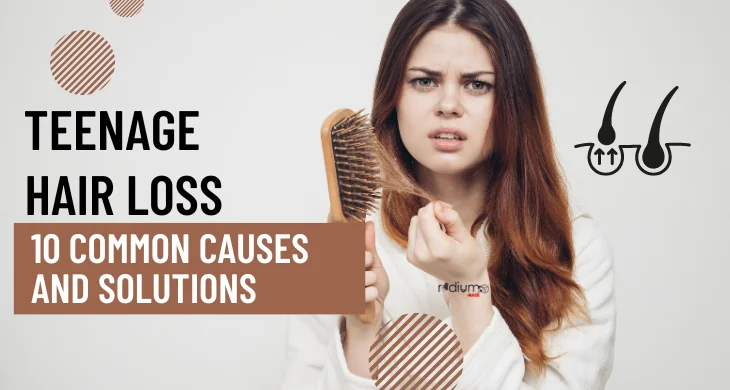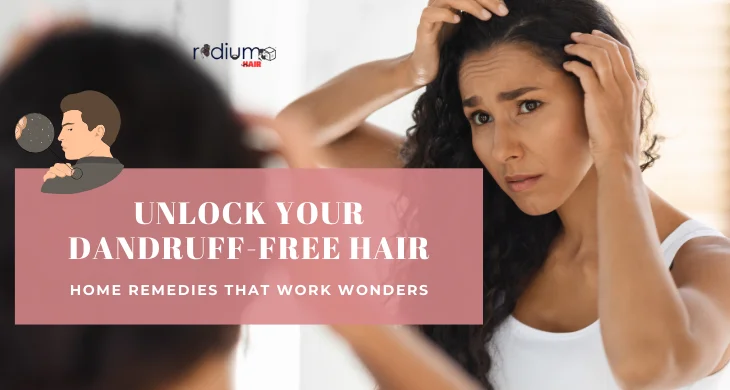Hair loss is commonly linked with advancing age, but when it occurs during adolescence, it can be particularly concerning and overwhelming. Numerous factors can play a role in teenage hair loss, encompassing a spectrum from genetic influences to lifestyle habits and underlying health issues. Understanding these underlying causes is crucial for effectively addressing and managing the problem. In this article, we’ll delve into the ten primary reasons why teenagers may experience hair loss and explore potential solutions to mitigate or reverse the condition. By shedding light on these factors and providing actionable insights, we aim to empower teenagers and their families to navigate this challenging issue with confidence and knowledge.
Signs and Symptoms of Teenage Hair Loss
Hair loss among teenagers can present itself in diverse forms, each indicating underlying issues that warrant attention. One of the earliest signs is a gradually receding hairline, where the hairline starts moving backward, leaving more of the forehead exposed. Scaling or patches on the scalp are also common signs, often accompanied by itching or discomfort. Experiencing excessive shedding of hair, where more than the usual 100 strands are lost per day, is another red flag that should not be ignored. Waking up to find clumps of hair on the pillow is alarming and indicative of potential hair loss issues. Sudden hair loss, characterized by rapid and unexpected shedding, can be distressing and may require immediate intervention. Bald patches, particularly when they appear in specific areas of the scalp, are clear indicators of hair loss problems. Hair thinning on the temples, where the hair becomes sparse and fine, is another common manifestation of teenage hair loss. Similarly, noticing a significant loss of hair on the frontal scalp, especially along the hairline, should prompt further investigation into potential causes. Recognizing these early signs and symptoms is essential for initiating timely interventions to address the underlying factors contributing to teenage hair loss and prevent further hair thinning or balding.
Common Causes of Teenage Hair Loss
- Male Pattern Baldness: Male pattern baldness, also known as androgenic alopecia, is a hereditary condition that predominantly affects males, with onset possible as early as the teenage years. This genetic predisposition to hair loss is characterized by a distinct pattern, often beginning with a receding hairline that gradually advances over time. As the condition progresses, individuals may also experience thinning or complete loss of hair on the crown or top of the head. While male pattern baldness can vary in severity from person to person, it is generally a progressive and irreversible condition. Despite its early onset, the impact of male pattern baldness on teenage males can be significant, affecting self-esteem and confidence. Understanding the genetic and hormonal factors underlying this condition is essential for exploring treatment options and managing its effects on both physical appearance and emotional well-being.
- Alopecia Areata: Alopecia areata is a chronic autoimmune disorder characterized by the body’s immune system mistakenly targeting hair follicles, leading to hair loss. This condition can manifest at any age, including during the teenage years, and affects both males and females. The hallmark symptom of alopecia areata is the development of small, round bald patches on the scalp, although it can also affect other hair-bearing areas of the body. The exact cause of alopecia areata remains unclear, but it is believed to involve a combination of genetic predisposition and environmental factors triggering an immune response against the hair follicles. While alopecia areata is not inherently harmful to physical health, it can have significant psychological and emotional impacts, particularly for teenagers already grappling with issues of self-image and identity. Treatment options for alopecia areata vary and may include topical or oral medications, corticosteroid injections, and other therapeutic approaches aimed at modulating the immune response and promoting hair regrowth.
- Trichotillomania: Trichotillomania is a psychiatric condition marked by the compulsive urge to pull out one’s hair, leading to significant hair loss over time. This disorder typically emerges during childhood or adolescence and can persist into adulthood if left untreated. Individuals with trichotillomania often experience a sense of tension or anxiety before pulling out their hair, followed by feelings of relief or gratification afterward. While the exact cause of trichotillomania remains unclear, it is believed to involve a combination of genetic, environmental, and psychological factors. The repetitive behavior associated with trichotillomania can result in noticeable bald patches on the scalp, eyebrows, or eyelashes, leading to distress and impairment in daily functioning. Treatment for trichotillomania may include therapy, medication, and behavioral interventions aimed at managing symptoms and reducing hair-pulling behavior. Early recognition and intervention are essential for addressing trichotillomania effectively and minimizing its impact on an individual’s quality of life.
- Medication: Hair loss in teenagers can sometimes be attributed to the side effects of certain medications commonly used to treat various health conditions. Medications prescribed for acne, depression, fungal infections, and high blood pressure have been linked to hair loss as a potential adverse effect. For example, medications like isotretinoin, commonly used to treat severe acne, have been reported to cause hair thinning or shedding in some individuals. Similarly, antidepressants and antifungal treatments may also disrupt the normal hair growth cycle, leading to increased hair loss. It’s essential for teenagers and their parents to be aware of the potential side effects of medications and to consult healthcare professionals if they notice any changes in hair health while taking medication. In some cases, healthcare providers may recommend alternative treatments or adjustments to medication dosage to minimize hair loss.
- Chemical Treatments: Hair styling trends among teenagers often involve chemical-based treatments like bleaching, perming, coloring, and straightening to achieve desired looks. While these treatments can temporarily alter hair texture and appearance, they can also cause significant damage to the hair shaft over time. Chemicals used in these processes penetrate the hair cuticle, weakening its structure and making it prone to breakage and hair loss. Bleaching, for example, involves stripping the hair of its natural pigment, which can leave it dry and brittle. Similarly, perming and straightening treatments rely on harsh chemicals to alter the hair’s natural shape, leading to increased susceptibility to damage. Regular exposure to these chemical treatments without proper care and maintenance can exacerbate hair loss issues among teenagers, emphasizing the importance of opting for gentler, more natural alternatives to protect hair health in the long term.
- Hormonal Imbalance: Hormonal imbalances, often associated with conditions like polycystic ovarian syndrome (PCOS), thyroid disease, and lupus, can significantly impact the hair growth cycle and lead to hair loss in teenagers. PCOS, characterized by hormonal irregularities such as elevated levels of androgens, can cause hair thinning and scalp issues due to increased sensitivity of hair follicles to androgens. Similarly, thyroid disorders, including hypothyroidism and hyperthyroidism, can disrupt hormone levels essential for hair growth, resulting in excessive shedding or hair thinning. Lupus, an autoimmune disease, can also affect hair follicles, leading to hair loss as the body’s immune system mistakenly attacks healthy cells, including those responsible for hair growth. Managing these hormonal conditions through medical intervention and lifestyle modifications is crucial in addressing hair loss concerns and restoring healthy hair growth patterns in teenagers affected by such disorders.
- Malnutrition: Insufficient intake of essential nutrients due to poor dietary habits can deprive the body of vital elements crucial for promoting healthy hair growth, thereby contributing to hair loss among teenagers. Nutrients like vitamins A, C, and E, along with minerals such as zinc and iron, play integral roles in maintaining the health of hair follicles and supporting the growth of strong, luscious hair. When the body lacks these nutrients due to an imbalanced or inadequate diet, it can negatively impact the hair growth cycle, leading to increased shedding, thinning, or weakened hair strands. Incorporating nutrient-rich foods like fruits, vegetables, lean proteins, and whole grains into the diet can help ensure an adequate supply of essential vitamins and minerals necessary for optimal hair health and mitigate the risk of hair loss associated with poor dietary choices.
- Stress: Teenagers often encounter various stressful life events, ranging from academic pressures and relationship issues to peer pressure, which can significantly impact their emotional well-being and overall health. Chronic stress triggers the release of hormones like cortisol, which can disrupt the normal hair growth cycle and lead to hair loss. Additionally, stress may also contribute to unhealthy coping mechanisms, such as poor dietary habits or inadequate self-care practices, further exacerbating the risk of hair loss. To mitigate the effects of stress-related hair loss, teenagers should prioritize self-care activities like regular exercise, adequate sleep, and mindfulness practices to manage stress levels effectively. Seeking support from trusted friends, family members, or mental health professionals can also provide valuable assistance in navigating challenging life circumstances and minimizing the adverse effects of stress on hair health.
- Ringworm: Fungal infections, such as ringworm, can wreak havoc on the scalp, leading to inflammation and scarring that disrupt the hair follicles’ normal function. Ringworm, despite its misleading name, isn’t caused by worms but rather by fungi known as dermatophytes, which thrive in warm, moist environments. When these fungi infect the scalp, they can cause red, scaly patches that may spread and result in hair loss. The inflammation and scarring associated with ringworm can damage the hair follicles, leading to hair thinning or bald patches in affected areas. Prompt treatment with antifungal medications is crucial to eradicate the infection and prevent further hair loss. Additionally, maintaining proper hygiene practices and avoiding sharing personal items like combs or hats can help reduce the risk of fungal infections and subsequent hair loss.
- Telogen Effluvium: Telogen effluvium is a transient hair loss condition marked by a significant increase in hair shedding, typically occurring a few months after a triggering event. Stressful situations, such as emotional turmoil or major life changes, can disrupt the hair growth cycle, pushing a large number of follicles into the resting phase (telogen). As a result, affected individuals may notice an alarming amount of hair loss during daily activities such as showering or brushing. Rapid weight loss, nutritional deficiencies, illness, surgery, or hormonal fluctuations can also contribute to telogen effluvium. While the shedding may be distressing, the good news is that telogen effluvium is usually temporary, and most people experience regrowth once the underlying trigger is addressed and the hair follicles transition back to the active growth phase (anagen). However, it’s essential to consult a healthcare professional to identify and address the root cause of hair loss effectively.
Treatment Options for Teenage Hair Loss
Addressing teenage hair loss requires a multifaceted approach tailored to the specific underlying factors contributing to the condition. Lifestyle modifications, such as managing stress levels, maintaining a balanced diet, and practicing good hair care habits, can play a crucial role in promoting scalp health and preventing further hair loss. Dietary changes aimed at ensuring adequate intake of essential nutrients, including vitamins, minerals, and proteins, can support optimal hair growth and overall well-being. Additionally, incorporating scalp-friendly practices like gentle hair washing with mild shampoos and avoiding harsh styling treatments can help minimize damage and encourage healthy hair growth.
In cases where lifestyle adjustments alone are insufficient, topical medications or treatments may be recommended to address specific issues such as inflammation, fungal infections, or hormonal imbalances contributing to hair loss. These treatments may include medicated shampoos, scalp serums, or corticosteroid creams, depending on the individual’s needs and the severity of the condition.
For more complex or persistent cases of teenage hair loss, professional intervention by a dermatologist or trichologist may be necessary to assess the scalp health comprehensively and develop a personalized treatment plan. This may involve diagnostic tests to identify underlying medical conditions, such as hormonal disorders or autoimmune diseases, and targeted therapies to address these issues effectively. By consulting with a qualified healthcare provider, teenagers can access the expertise and resources needed to navigate their hair loss journey and achieve optimal outcomes for scalp health and hair regrowth.
Conclusion
In conclusion, while teenage hair loss can be distressing, it is often manageable with the right approach. By addressing underlying causes and adopting healthy hair care practices, teenagers can promote hair growth and restore their confidence.
Remember, addressing hair loss early can lead to better outcomes, so don’t hesitate to seek professional advice if you’re concerned about your hair health.
Frequently Asked Questions
Que: What should I do if I notice hair loss during my teenage years?
Ans: If you notice hair loss during your teenage years, it’s essential to consult a dermatologist or trichologist for proper evaluation and guidance on potential treatment options.
Que: Are there any natural remedies for teenage hair loss?
Ans: Yes, several natural remedies, such as coconut oil, aloe vera, and essential oils like tea tree oil, may help alleviate teenage hair loss by nourishing the scalp and promoting hair growth.
Que: Can hormonal imbalances cause hair loss in teenagers?
Ans: Yes, hormonal imbalances, such as those associated with conditions like polycystic ovarian syndrome (PCOS) or thyroid disorders, can contribute to hair loss in teenagers.
Que: Is it normal to lose hair during adolescence?
Ans: Yes, it’s normal to experience some degree of hair loss during adolescence due to hormonal changes and other factors, but excessive or rapid hair loss may indicate an underlying issue that requires attention.



